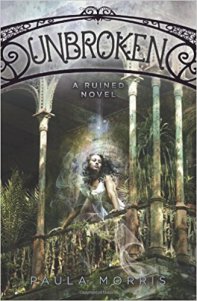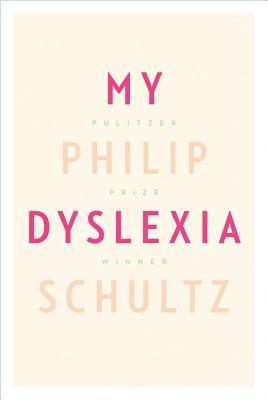Kaitlyn Dunnett/Kathy Lynn Emerson here. Back when I worked in the circulation department at Mantor Library at the University of Maine at Farmington in the 1980s, part of my job was re-shelving returned books. We used to joke that the job would be so much easier if they were all the same size. I found myself remembering that last week, when the paperback reprint of the tenth Liss MacCrimmon mystery, Kilt at the Highland Games, hit stores.
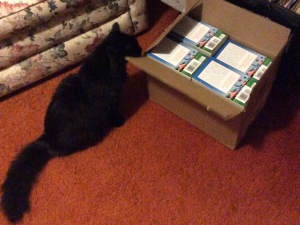
Bala inspects the newly arrived box of author copies
We don’t have to contend with oversized books in the mystery genre, but there are three distinct print formats. Despite dire predictions about the changes wrought by the e-book revolution and the decision by some publishers to eliminate mystery imprints, I don’t see that changing anytime soon.
It isn’t always clear to readers (or writers, for that matter) why one book is published in hardcover first and then, about a year later, as a mass market paperback, and another comes out only as a trade paperback or only as a mass market paperback original. From the publisher’s point of view, there are financial considerations to do with printing and distribution. I’m not going to get into those. I’m not even sure I really understand them. What I will ramble on about for a bit is my own experience with all three formats.
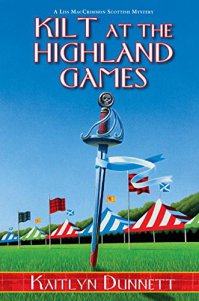 Back in the 1990s, when I was writing category romance and historical romantic suspense, my books were published as paperback originals. Decades later, when I wrote my “Secrets of the Tudor Court” novels, they were published in trade paperback. To distinguish between historical romance and historical? I truly have no idea, nor did I have any say in the decision. Trade paperbacks are nearly the size of a hardcover but are easier and lighter to handle and cheaper to produce. The three books in my historical Mistress Jaffrey Mysteries, came out first in hardcover, but also in large print, e-book, and trade paperback. The hardcovers are expensive, making the trade paperback look like a much better deal to the average reader. There is no mass market option.
Back in the 1990s, when I was writing category romance and historical romantic suspense, my books were published as paperback originals. Decades later, when I wrote my “Secrets of the Tudor Court” novels, they were published in trade paperback. To distinguish between historical romance and historical? I truly have no idea, nor did I have any say in the decision. Trade paperbacks are nearly the size of a hardcover but are easier and lighter to handle and cheaper to produce. The three books in my historical Mistress Jaffrey Mysteries, came out first in hardcover, but also in large print, e-book, and trade paperback. The hardcovers are expensive, making the trade paperback look like a much better deal to the average reader. There is no mass market option.

The Liss MacCrimmon Mysteries are published in what’s called a hard/soft deal. Hardcovers are what libraries want, and libraries, even in difficult financial times, still buy books. Hardcovers, however, are expensive to produce. Full price tends to be $25 or more. The e-book editions that come out at the same time are also more expensive, as in over $10. The good news for cash-strapped book lovers is that there will eventually be a paperback reprint. Once that is in stores, the price of the e-book also drops.
It’s hard to make generalizations about book publishing, but what seems to be the norm in the mystery genre is that series in hardcover or trade paperback publish one new book in that series per year while series that are mass market paperback originals have a new entry every six months or so. An aside: I’m talking about books from traditional, royalty-paying publishers here, not books produced by the authors themselves. Indie publishers can bring out as many or as few books a year as they choose and price them however they like as well. Most of them, if there is a print edition, choose the trade paperback size.
To make a living at writing, most writers have to write two or more books a year. A deadline every six months can be grueling, whether the book is supposed to be 70,000 words or 100,000. It doesn’t allow much leeway for ill health, family emergencies, or anything else. I admire writer friends who manage two books in the same series year after year and still manage to keep the plots and characters fresh. I regularly write two or three novels a year, but not in the same series. I need a break in order to recharge my batteries and rekindle my enthusiasm.
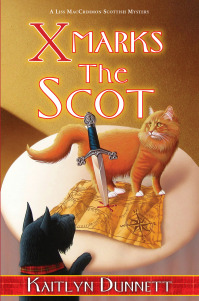
I’ll tell you a little secret. When I wrote Kilt at the Highland Games I thought it was going to be the last book in the Liss MacCrimmon series. I was out of ideas for Liss and her friends, fearful that I’d just be repeating myself if I wrote any more about them. I came up with a proposal for a new series with a different setting, a different (older) sleuth, and a different profession, to be written from a different point of view—first person instead of third. But a funny thing happened during the long process of selling that series to my publisher. Simply by working on something else for awhile, and encouraged by the fact that Kensington wanted more Liss MacCrimmon mysteries, new ideas started popping into my head. I wasn’t finished with Liss after all. Before I knew it, I had a plot for the eleventh book in the series, X Marks the Scot, which will be out in hardcover at the end of November. And the series written about in first person with an older woman as amateur detective? The first book in the “Deadly Edits” series, Crime and Punctuation, will be out in hardcover in June of 2018.
Although I delight in having a “new” paperback in stores, there’s no rest for the wicked. The twelfth Liss MacCrimmon Mystery, Overkilt, is due on my editor’s desk on December first, I need to come up with a plot for Liss #13 by March first, and Clause and Effect has a June first deadline. Whether they come out in hardcover, trade paperback, or mass market, mystery series keep their writers busy!
 Kathy Lynn Emerson/Kaitlyn Dunnett is the author of more than fifty traditionally published books written under several names. She won the Agatha Award and was an Anthony and Macavity finalist for best mystery nonfiction of 2008 for How to Write Killer Historical Mysteries and was an Agatha Award finalist in 2015 in the best mystery short story category. She was the Malice Domestic Guest of Honor in 2014. Currently she writes the contemporary Liss MacCrimmon Mysteries (X Marks the Scot—December 2017) and Deadly Edits series (Crime and Punctuation—2018) as Kaitlyn and the historical Mistress Jaffrey Mysteries (Murder in a Cornish Alehouse) as Kathy. The latter series is a spin-off from her earlier “Face Down” mysteries and is set in Elizabethan England. New in 2017 is a collection of short stories, Different Times, Different Crimes. Her websites are www.KaitlynDunnett.com and www.KathyLynnEmerson.com
Kathy Lynn Emerson/Kaitlyn Dunnett is the author of more than fifty traditionally published books written under several names. She won the Agatha Award and was an Anthony and Macavity finalist for best mystery nonfiction of 2008 for How to Write Killer Historical Mysteries and was an Agatha Award finalist in 2015 in the best mystery short story category. She was the Malice Domestic Guest of Honor in 2014. Currently she writes the contemporary Liss MacCrimmon Mysteries (X Marks the Scot—December 2017) and Deadly Edits series (Crime and Punctuation—2018) as Kaitlyn and the historical Mistress Jaffrey Mysteries (Murder in a Cornish Alehouse) as Kathy. The latter series is a spin-off from her earlier “Face Down” mysteries and is set in Elizabethan England. New in 2017 is a collection of short stories, Different Times, Different Crimes. Her websites are www.KaitlynDunnett.com and www.KathyLynnEmerson.com


